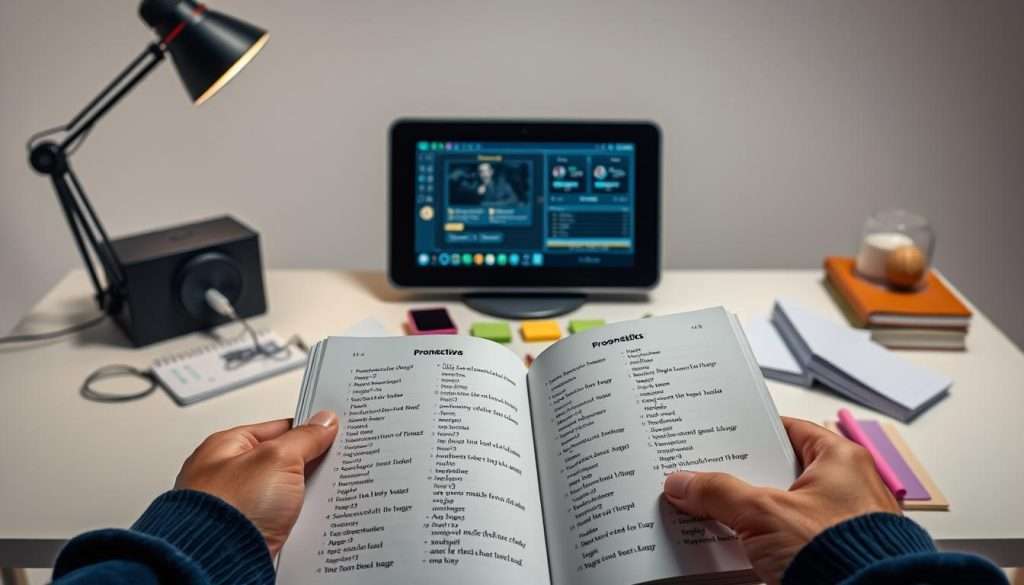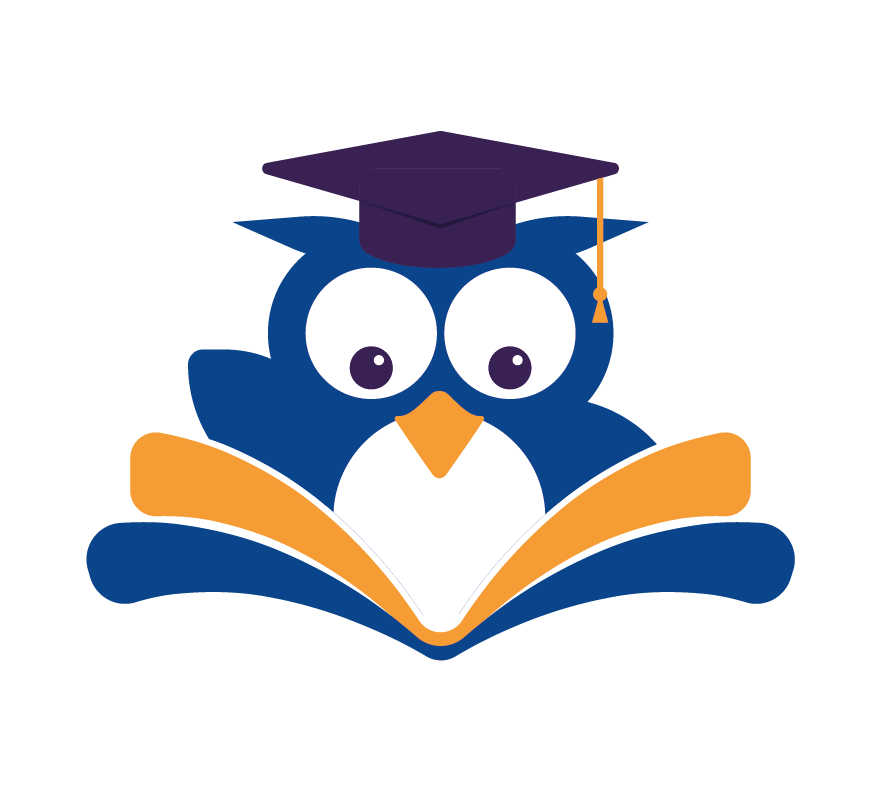Becoming bilingual is an exciting journey. It opens doors to new cultures and broadens your perspectives. With the right strategies, anyone can master a new language and enjoy its benefits.
In this article, we’ll explore effective methods for language learning. We’ll share practical tips to keep you motivated. Whether you’re a student or a lifelong learner, our guide makes bilingual education accessible and enjoyable.
Key Takeaways
- Discover the benefits of being bilingual in today’s globalized world.
- Learn effective strategies to stay motivated throughout your language learning journey.
- Explore different methods and tools for language learning.
- Understand how bilingual education can enhance your career and personal growth.
- Get practical tips on how to incorporate language learning into your daily routine.
The Benefits of Becoming Bilingual
Starting your bilingual journey opens up a world of benefits. It’s not just about speaking two languages. It’s about unlocking new opportunities.
Cognitive Advantages
Becoming bilingual boosts your brainpower. It improves your memory and problem-solving skills.
Enhanced Memory and Problem-Solving
Bilingual people have better memory and problem-solving. This is because they constantly switch between languages. This skill is valuable in many areas of life.
Delayed Cognitive Aging
Studies show bilingualism can slow down brain aging. This means bilingual people might stay sharp longer than others.
Career Opportunities
In today’s world, speaking two languages is a big plus. It can lead to new job opportunities and give you an edge.
| Industry | Benefits of Being Bilingual |
|---|---|
| Business | Enhanced communication with international clients and partners |
| Education | Increased job opportunities in bilingual education |
| Healthcare | Ability to communicate with patients from diverse linguistic backgrounds |
Cultural Understanding and Connection
Becoming bilingual lets you connect with cultures deeply. You’ll understand the language’s nuances and appreciate the culture more.
Assessing Your Language Learning Goals
Understanding your goals in learning a new language is key. It keeps you focused and motivated. It’s about knowing why you want to learn a new language and what you hope to achieve.
Determining Your Purpose
Your reason for learning a new language could be many things. It might be to get a better job, connect with your roots, or make traveling easier. Knowing your purpose helps you learn in a way that suits you best.
Setting Realistic Timeframes
Choosing a realistic time frame is important. It depends on the language’s difficulty and your current level. Be honest about how much time you can commit to learning.
Choosing the Right Language for Your Needs
There are many languages to choose from. Pick one that fits your interests, needs, and challenges. Here’s a quick guide to help you decide:
| Language | Utility | Cultural Significance |
|---|---|---|
| Spanish | High | Rich cultural heritage |
| French | Moderate | Significant cultural influence |
| Mandarin | High | Growing economic importance |
Understanding Your Learning Style
Discovering your learning style is like finding the right key to unlock your language learning potential. We all absorb information differently. Knowing if you’re a visual, auditory, or kinesthetic learner can make learning better.
Visual Learners: Strategies and Resources
If you’re a visual learner, you love images, diagrams, and videos. You might enjoy:
- Watching language learning videos on YouTube
- Using flashcards with images
- Reading language learning apps with visual aids
Auditory Learners: Effective Approaches
Auditory learners do well with sound. Try:
- Listening to language learning podcasts
- Engaging in audio conversations with native speakers
- Using language learning apps with audio components
“The way we learn is as unique as our fingerprints.”
Kinesthetic Learners: Hands-on Techniques
Kinesthetic learners like hands-on experiences. You can:
- Participate in language exchange meetups
- Use interactive language learning apps
- Practice speaking while doing activities
| Learning Style | Effective Methods | Recommended Resources |
|---|---|---|
| Visual | Videos, Flashcards | YouTube, Language Apps |
| Auditory | Podcasts, Audio Conversations | Podcasts, Language Exchange |
| Kinesthetic | Language Meetups, Interactive Apps | Meetup.com, Interactive Language Apps |
Best Methods to Learn a Second Language
Becoming bilingual is within reach when you choose the right language learning approach for your needs. There are many methods to learn a language, like structured courses, self-study, and immersive approaches. The key is to find what works best for you and your learning style.
Structured Courses vs. Self-Study
Structured courses offer a systematic way to learn a language, with a curriculum that gets more challenging as you progress. This method is great for those who like a classroom setting or need structure to stay motivated. On the other hand, self-study lets you learn at your own pace and focus on what interests you most. Many people find success by using both methods to achieve language fluency.
The Communicative Approach
The communicative approach focuses on practical, real-life communication skills. It encourages learners to speak even if they’re not perfect, to build confidence and fluency. This method works well when combined with immersion programs or language exchange partners.
Task-Based Learning
Task-based learning involves completing tasks that require the use of the target language to achieve a goal. This could be anything from ordering food at a restaurant to giving directions.
Real-World Application Exercises
Real-world application exercises are a crucial part of task-based learning. Examples include:
- Creating a shopping list in the target language
- Writing a short essay on a current event
- Engaging in a role-play scenario, like a job interview
Language learning expert Stephen Krashen says, “Acquisition requires meaningful interaction in the target language – natural communication – in which speakers are concerned not with the form of their utterances but with the messages they are conveying and understanding.” This highlights the importance of practical, communicative approaches to language learning.
| Method | Description | Benefits |
|---|---|---|
| Structured Courses | Systematic approach to language learning | Provides a clear progression path, classroom environment |
| Self-Study | Learners pace themselves | Flexibility, focus on personal interests or weaknesses |
| Communicative Approach | Focus on practical communication | Builds confidence, fluency in real-life situations |
Essential Tools for Language Acquisition
In today’s digital age, becoming bilingual is easier than ever. This is thanks to many language learning tools available. But what are the most effective tools to help you achieve language proficiency?
Language Learning Apps and Platforms
Language learning apps have changed how we learn new languages. They offer flexibility, personalization, and engagement. Let’s take a closer look at some of the most popular ones:
Duolingo, Babbel, and Rosetta Stone
- Duolingo: Known for its gamification approach, making learning fun and competitive!
- Babbel: Focuses on conversational skills, with a comprehensive curriculum that’s both interactive and engaging.
- Rosetta Stone: Utilizes immersive, interactive lessons that simulate real-life conversations.
Each of these apps has its unique strengths. But which one is right for you?
Online Courses and Resources
Online courses offer structured learning, often with the opportunity to interact with instructors and peers. Some notable platforms include:
- MOOCs (Massive Open Online Courses) like Coursera and edX
- Specialized language learning platforms like italki
These resources can be a great way to supplement your learning. They offer a range of courses and study materials.
Traditional Learning Materials
While digital tools are incredibly popular, traditional learning materials still have their place. Textbooks, language learning books, and flashcards can be very effective. They can be especially useful when combined with modern digital tools.
Immersion Techniques for Rapid Learning
Dive into the world of language immersion. Learn how being surrounded by a new language speeds up your learning. Immersion is a top method to get language fluency by being in the language all the time.
Creating an Immersive Environment at Home
You don’t have to go abroad to immerse yourself in a language. You can do it at home. Just change your phone settings to the target language. Watch TV shows or movies in the original language.
Listen to music or podcasts in the target language. You can also label things at home with their names in the target language. This helps you get used to new words.

Language Exchange Programs
Language exchange programs are great for practicing with native speakers. You can find partners online or at local meetups. This method improves your speaking skills and lets you learn about different cultures.
It also helps you make new friends.
Study Abroad and Travel Immersion
For a deep immersion, study abroad or travel to a country where your target language is spoken. Being around the language and culture all day boosts your learning. Here’s a comparison of different immersion techniques:
| Immersion Technique | Effectiveness | Cost |
|---|---|---|
| Home Immersion | High | Low |
| Language Exchange | Medium | Low |
| Study Abroad | Very High | High |
By using these immersion programs in your language learning, you’ll speak fluently soon. The secret to learning a language is consistent practice and exposure.
Mastering Vocabulary Acquisition
Learning new words is an exciting journey. With the right strategies, you can become bilingual. A strong vocabulary is key for good communication in a new language.
Spaced Repetition Systems
Spaced repetition systems are a great way to learn new words. This method reviews words at longer intervals to help you remember them better. Apps like Anki and Quizlet use this technique.
Contextual Learning Strategies
Learning words in context is very effective. Instead of just memorizing lists, try reading authentic materials like news or books in your target language. This way, you see how words are used in real life.
Memory Techniques and Mnemonics
Mnemonics and other memory tricks can help you remember words better. For example, linking a new word to a personal experience or a clear image can make it stick in your mind.
| Technique | Description | Example |
|---|---|---|
| Spaced Repetition | Reviewing words at increasing intervals | Using Anki to review vocabulary |
| Contextual Learning | Learning words in context | Reading news articles in the target language |
| Mnemonics | Using associations to remember words | Associating a word with a personal experience |
Developing Strong Grammar Foundations
Understanding grammar is like building a strong foundation for a house – it’s essential for stability. When you grasp the grammar rules, you can express yourself more effectively and understand others better. We will explore how to develop strong grammar foundations.
Pattern Recognition Approach
The pattern recognition approach involves identifying and learning common grammar patterns. This method helps you understand how to use grammar in context. By recognizing patterns, you can apply them to different situations, making it easier to learn and remember grammar rules.
Progressive Learning Methods
Progressive learning methods involve gradually increasing the complexity of grammar rules as you progress. This approach helps to prevent overwhelm and builds confidence. You can start with simple rules and gradually move on to more complex ones, reinforcing your understanding at each step.
Avoiding Common Grammar Pitfalls
Common grammar pitfalls include confusing verb tenses, misusing prepositions, and incorrect sentence structure. Being aware of these pitfalls can help you avoid making mistakes. By understanding the most common errors, you can focus on improving these areas and develop a more accurate understanding of grammar.
To become proficient in a language, it’s essential to practice regularly and review grammar rules frequently. You can use a variety of resources, such as grammar guides, online exercises, and language learning apps, to help you improve your grammar skills.
Improving Pronunciation and Accent
Learning a new language? Improving your pronunciation is key to speaking well. It makes you sound natural and confident in your new language.
Active Listening and Mimicking
Active listening and mimicking are great for improving your pronunciation. Listen to native speakers and try to mimic their way of speaking. This includes their tone, rhythm, and how they pronounce words. Try listening to podcasts, audiobooks, or language learning videos and repeat what they say.
Working with Native Speakers
Practicing with native speakers is another excellent way to get better. Join language exchange programs or have conversations with native speakers. They can give you real-time feedback to help you improve your pronunciation.
Technology-Assisted Pronunciation Practice
There are many language learning apps and tools to help you practice pronunciation. Some apps use AI to check your pronunciation and give you feedback. You can also find online resources like pronunciation guides and videos to practice with.
| Method | Description | Benefits |
|---|---|---|
| Active Listening | Listen to native speakers and mimic their pronunciation. | Improves accent and intonation. |
| Language Exchange | Practice with native speakers through language exchange programs. | Provides real-time feedback. |
| Technology-Assisted | Use apps and online resources for pronunciation practice. | Offers personalized feedback and flexibility. |

By using these methods, you can greatly improve your pronunciation and accent. This will help you communicate more effectively in your target language.
Building Conversation Skills
Are you ready to boost your language learning by improving your conversation skills? It’s key for effective communication in a second language. It’s not just about understanding and being understood; it’s about being able to converse with confidence and connect with others.
Overcoming Speaking Anxiety
One big hurdle is overcoming speaking anxiety. It’s normal to feel nervous when speaking a new language. But, there are ways to manage this anxiety. Practice is key! The more you practice speaking, the more comfortable you’ll become.
Finding Conversation Partners
Finding someone to converse with is crucial. You can find conversation partners through language exchange apps or by attending language meetups. These platforms connect you with others who are learning or native speakers, providing a safe space to practice your skills.
Language Exchange Apps and Meetups
- Language exchange apps like Tandem and HelloTalk
- Meetup groups focused on language exchange
- Local language schools or community centers
Practical Dialogue Exercises
To improve your conversation skills, try engaging in practical dialogue exercises. Role-playing is a fun and effective way to practice real-life conversations. You can also listen to dialogues and repeat them to improve your pronunciation and intonation.
Maintaining Motivation Throughout Your Journey
Learning a new language takes a lot of effort and motivation. As you get better, it’s key to keep your excitement and dedication alive.
Setting Milestone Achievements
Divide your language learning goals into smaller, reachable steps. This makes it easier to stay motivated. You can see your progress and know what’s next.
Joining Language Learning Communities
Meeting others who love learning languages can really boost your motivation. Look for online forums, language meetups, or exchange programs. They offer a chance to connect with people who share your interests.
Celebrating Progress and Small Wins
Always celebrate your successes, no matter how small. This positive feedback keeps you motivated and excited about your language learning journey.
| Motivation Strategies | Description | Benefits |
|---|---|---|
| Setting Milestones | Break down goals into smaller targets | Increased focus and motivation |
| Language Communities | Join online forums or language meetups | Supportive environment and networking |
| Celebrating Progress | Acknowledge and celebrate achievements | Positive reinforcement and motivation |
Conclusion: Your Path to Bilingual Success
Becoming bilingual is within reach with the right mindset and strategies. We’ve looked at the benefits, like better thinking and more job chances. By knowing your goals and how you learn, you can get good at a new language.
Learning through immersion, getting new words, and understanding grammar are key. Also, working on your speaking, talking more, and staying motivated are important. Now, you have the tools to move forward in your language learning.
Keep going, and soon you’ll speak a new language with ease. Learning a language is a great adventure that brings new cultures and chances. We urge you to keep going, using all the resources to help you become bilingual.

